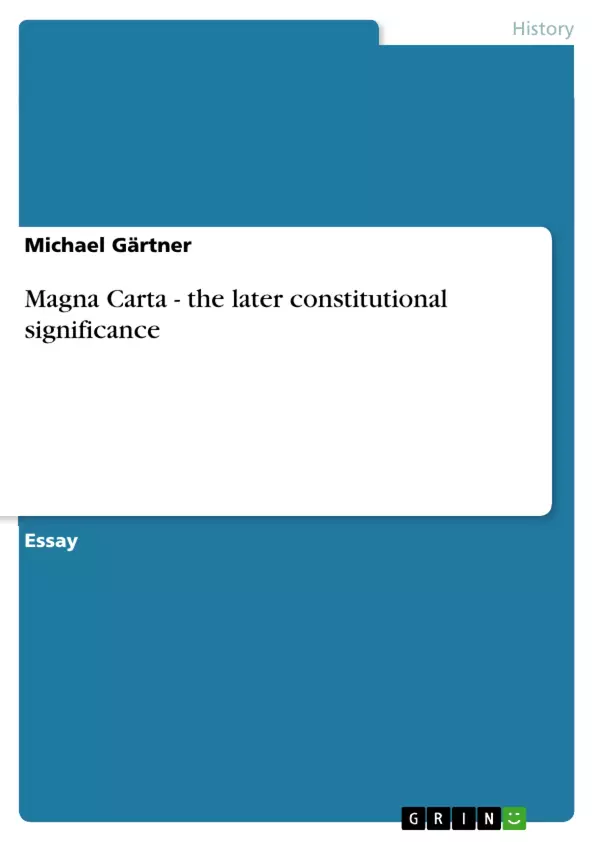England is rightfully seen as the birthplace of parliamentarinism, which reaches back
to the Magna Carta. Even the Anglo Saxon period knew an early form of parliament,
the “witenagemont”1. This was the council of the elders and it did not end with the
invasion by William the Conqueror – instead a council2 of the crown vassals was
introduced, but with roots in the “witenagemont”. William the Conqueror was
crowned King of England in 1066 and his reign marks the end of several invasions,
which had begun since 450 AD. After the Roman withdrawal from the British Isles
the resulting power vacuum encouraged invaders from the continent. The Romano-
British neither had the weapons nor the army to make use of the Roman military
structures and fell back on their traditional hill forts but were ultimately unable to stop
the German advances. The Anglo-Saxons and Danes founded several kingdoms in
England. They were predominantly peasants and forest dwellers and fortified their
villages and towns with earthen banks and timber palisades and constructed massive
earthworks along the borders of their Kingdoms.
To return to the Normans, the Norman castle was not just a new form of
military architecture; it was the product of a complex military society that had been
created in Europe during the 9th and 10th centuries AD. The feudal system was an
acknowledgement of the difficulty of running and defending a large country without a
well-developed administrative system, without efficient communication, and without
a standing army. In theory at least, all land belonged3 to the King and was held as a
fee or payment from him in return for various political, administrative and military
services. [...]
1 danaelayne.com/anglosaxons.ppt (21.02.2003)
2 This was the Magnum Concilium.
3 Kurt Kluxen, Geschichte Englands (Stuttgart: Kroener Verlag, 1991), 40.
Table of Contents
- Liberty means responsibility.
- England is rightfully seen as the birthplace of parliamentarinism.
- The Norman castle was not just a new form of military architecture.
- Many of the great barons behaved at times like independent princes.
- At Runnymede, on 15 June 1215, King John of England sealed the Magna Carta.
- Only when the Magna Carta was made official did the English aristocracy become more self-confident.
- Westminster Hall¹s was also the site of the first true English parliament in 1265.
- The position of Parliament was strengthened at the beginning of the war against France.
- The Wars of the Roses finally brought the country to the brink of disaster.
- In 1461 the House of York obtained the crown after some difficulties.
- In the reign of the first Tudor king Henry VII, the authority of Parliament was further reduced.
- After the setbacks under Henry VII, Parliament was now able to strengthen itself again.
Objectives and Key Themes
This work aims to explore the historical development and constitutional significance of the Magna Carta, examining its impact on the evolution of English parliamentarianism and the growth of individual rights. It explores the complex relationship between the monarchy, the nobility, and the people in shaping the English political system.
- The origins and evolution of the Magna Carta
- The impact of the Magna Carta on English constitutional thought
- The role of Parliament in the development of English government
- The changing power dynamics between the monarchy, the nobility, and the commoners
- The influence of the Magna Carta on later political and social developments
Chapter Summaries
- The text begins by outlining the historical context of the Magna Carta, tracing its origins back to the Anglo-Saxon period and the Norman Conquest. It discusses the development of the feudal system and the role of castles in the administration and defense of the country.
- The second chapter focuses on the signing of the Magna Carta in 1215, outlining the circumstances surrounding King John's concession of legal rights to his barons and the people. It highlights the importance of the document in establishing the principle of rule of law and limiting the arbitrary power of the monarch.
- The third chapter examines the period following the Magna Carta, analyzing the development of Parliament and the increasing influence of the nobility in English government. It discusses the Provisions of Oxford and the rise of Simon de Montfort, who challenged the authority of the monarchy and introduced new ideas of constitutional monarchy.
- The fourth chapter explores the Wars of the Roses, which brought the country to the brink of disaster, and the subsequent rise of the Tudor dynasty. It discusses the role of Parliament in this turbulent period, noting its loss of authority and its later reassertion of power.
- The fifth chapter examines the reign of Henry VIII and the English Reformation, highlighting the role of Parliament in the secularization process. It details the importance of Parliament in supporting the Crown's initiatives and the growing influence of the English Parliament.
Keywords
The primary keywords and focus topics of the text are Magna Carta, English parliamentarianism, constitutionalism, feudalism, monarchy, nobility, commoners, rule of law, individual rights, Wars of the Roses, Tudor dynasty, and English Reformation. These terms encapsulate the central themes and historical developments examined in the work.
- Citar trabajo
- Michael Gärtner (Autor), 2003, Magna Carta - the later constitutional significance, Múnich, GRIN Verlag, https://www.grin.com/document/13981



